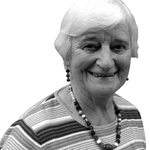On the pilgrim way: ‘How can they live with a history like that?’ - Reform Magazine
Sheila Maxey explores war and worship
 We are just back from 11 days cruising through Ukraine, down the Dnieper River and then up the Danube. Each morning at 6.45am I joined other early birds and sat silently in the bow with my cup of tea, watching the sun come up. It was a time to give thanks for so much – for the beauty of sky and river, for still being able to have such holidays together, and much more.
We are just back from 11 days cruising through Ukraine, down the Dnieper River and then up the Danube. Each morning at 6.45am I joined other early birds and sat silently in the bow with my cup of tea, watching the sun come up. It was a time to give thanks for so much – for the beauty of sky and river, for still being able to have such holidays together, and much more.
But it was also a time to ask for discernment in the face of all we were seeing and hearing about Ukraine from our local guides. During the cruise, we were shown a Polish film on the history of Ukraine and I was appalled by its blood-soaked history, especially in the 20th century. Millions died of starvation in two famines, largely caused by a deliberate Moscow policy of selling the harvest abroad to earn money for massive industrialisation. Ukrainian intellectuals and nationalists were shot or sent to the gulags. Many Ukrainian peasants were relocated to the east and Russians were brought in to work in the new industries. Ukrainians and Poles killed each other in the aftermath of the First World War’s redrawing of borders. In the Second World War, Ukrainians were both victims and killers, and probably about five million people died. How can today’s people (God’s people) live together in harmony with a history like that?
We spent two days in the beautiful city of Odessa. It is particularly proud of its mixture of peoples and its tolerance. During the Soviet period, all places of worship were either closed, or used for other purposes, or destroyed. During the Second World War, the large, prosperous Jewish community was mostly exterminated but today it is a young and growing community again, with a Jewish school and college.
We visited a beautiful mosque and a refurbished Lutheran church which serves the small, remaining German community. The glorious golden domes of the Orthodox churches dominate, and wherever we visited, at whatever time of day, there were men and women, young and old, standing there praying, crossing themselves, bowing, lighting candles while the priest chanted. There is a newly painted Catholic church which mainly serves the Polish community but has some services in English for passing sailors. Perhaps it is through worship that the terrible wounds may be healed – provided the various worshipping communities respect one another.
A forgiving approach to the past is also vital. In Zaporizhia, we passed an enormous dam. It was completed in 1932 at the height of the second famine – but our guide stressed that it saved lots of lives because the thousands of workers on the dam were fed.
And celebration helps. We heard wonderful Ukrainian folk singing, and also a national male voice choir. In an isolated fishing village, schoolchildren danced for us. God bless Ukraine.
Sheila Maxey is Book Reviews Editor for Reform
___
This article was published in the November 2017 edition of Reform










Submit a Comment